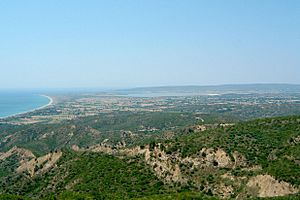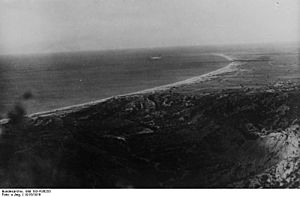Landing at Suvla Bay facts for kids
Quick facts for kids Landing at Suvla Bay |
|||||||
|---|---|---|---|---|---|---|---|
| Part of the Gallipoli campaign of Middle Eastern theatre of World War I | |||||||
 Suvla Bay, from Battleship Hill in the south |
|||||||
|
|||||||
| Belligerents | |||||||
|
|||||||
| Commanders and leaders | |||||||
|
|
|||||||
| Units involved | |||||||
| IX Corps | Gallipoli and Bursa Gendarmerie Battalions (initial) 7th Division 12th Division |
||||||
| Strength | |||||||
| 2 divisions (initial) 27,000 men (final) |
1,500 men (initial) 3,000 men (final) |
||||||
| Casualties and losses | |||||||
| 21,500 | 9,000–20,000 | ||||||
The Landing at Suvla Bay was an important event during World War I. It was a surprise attack by British forces on the Gallipoli peninsula in the Ottoman Empire. This landing happened on the night of August 6, 1915. The goal was to help British and ANZAC (Australian and New Zealand Army Corps) troops who were already fighting nearby.
Even though the landing started well against weak resistance, it quickly went wrong. The British commanders made many mistakes. The attack soon got stuck, just like other battles in the Battle of Gallipoli. On August 15, the British commander at Suvla, Frederick Stopford, was removed from his position. Many people consider his leadership one of the worst examples in the First World War.
Contents
Why Did the Suvla Bay Landing Happen?
In June 1915, leaders in London decided to send more troops to Gallipoli. They wanted to restart the campaign and break the deadlock. General Sir Ian Hamilton received five new army divisions.
The original plan was to break out from the Anzac area. However, there wasn't enough space for all the new troops there. So, a new landing at Suvla Bay was planned. The idea was for these new forces to land at Suvla and then connect with the Anzac troops.
Who Led the Suvla Bay Attack?
The new British IX Corps was chosen for the Suvla landing. This group included the 10th (Irish) Division and the 11th (Northern) Division. Sir Frederick Stopford was put in charge of IX Corps.
Stopford was 61 years old and had retired in 1909. He had little combat experience and had never led troops in battle. Many historians believe he was not the right person for such an important job.
How Was the Suvla Bay Landing Planned?
The attack was set to begin on August 6, 1915. Other battles would happen at Helles and Anzac to distract the enemy. The Suvla landing would start at 10:00 pm.
The main goal for IX Corps was to capture the hills around the Suvla plain. These hills included Kiretch Tepe to the north, Tekke Tepe to the east, and the Anafarta Spur to the south-east.
Commander Stopford's Decisions
When Stopford first saw the plan, he liked it. But his chief-of-staff, Hamilton Lyster Reed, had doubts. Reed thought attacks on enemy positions needed strong artillery support. Even though there were no strong defenses at Suvla, Stopford decided to limit the attack's goals. His final orders were not very clear, only saying the high ground should be taken "if possible."
Stopford also wanted some troops to land directly inside Suvla Bay. Unlike earlier landings, IX Corps had special armored landing craft called "Beetles." These boats could move on their own.
Ottoman Empire's Defense
The Ottoman commander, General Otto Liman von Sanders, knew a new landing was coming. But he wasn't sure where it would happen. British tricks made him think a landing might happen on the Asian side. So, he kept many troops there.
Suvla was defended by only about 1,500 Ottoman soldiers. They were part of the "Anafarta Detachment," led by Major Wilhelm Willmer. His job was to slow down any enemy advance until more troops arrived. Willmer's forces had no machine guns and only a few small cannons.
When the British began landing 20,000 soldiers at Suvla, they faced only 1,500 Ottoman defenders.
The Landing at Suvla Bay
The landing started just before 10 pm. Two companies of British soldiers quickly captured a small hill called Lala Baba. This hill overlooked the beach. They faced heavy losses, but they succeeded.
However, other landings went wrong from the start. Some ships anchored too far away, and soldiers had to wade ashore in deep water. Units got mixed up in the dark, and officers couldn't find their positions or goals. When the moon rose, British troops became easy targets for Ottoman snipers.
Attempts to capture Hill 10 failed because no one knew where it was. It was finally taken after dawn, but the Ottoman defenders had already left.
Stopford's Lack of Action
Commander Stopford chose to lead the landing from a ship, HMS Jonquil. He even went to sleep while the landing was happening. The first news he got was at 4 am when another commander told him not to land more troops in Suvla Bay.
A British war reporter, Ellis Ashmead-Bartlett, saw the landing at dawn. He noticed that Suvla was quiet compared to Anzac. He felt that "no firm hand appeared to control this mass of men suddenly dumped on an unknown shore." The official British history called the situation "verging on chaos."
By the end of the first day, August 7, progress was very small. The British IX Corps had suffered 1,700 casualties, which was more than the entire Ottoman force defending Suvla. Major Willmer reported to his commander: "No energetic attacks on the enemy's part have taken place. On the contrary, the enemy is advancing timidly."
General Von Sanders then ordered two more Ottoman divisions to move to Suvla. Stopford did not go ashore from his ship on August 7. The British command system had completely broken down.
Slow Progress and Dismissals
Stopford was happy with the first day's results. On the morning of August 8, he told General Hamilton that his troops deserved credit and that he would now "consolidate the position." He did not plan to advance to the high ground.
Hamilton was very upset by the lack of progress. He sent staff officers to find out what was happening. They found Stopford "in excellent spirits" on his ship, satisfied with the progress. When asked why the men hadn't reached the high ground, Stopford replied, "No, but they are ashore."
Finally, on the afternoon of August 8, Hamilton understood the situation. He went to Stopford's ship to confront him. Stopford and his officers planned to advance the next morning. But Hamilton insisted they attack immediately.
So, at 6:30 pm, a British brigade was ordered to march to the Tekke Tepe ridge. The march was difficult in the dark over rough land. They reached the summit at 4 am on August 9. But Ottoman reinforcements had arrived just before them. The exhausted British soldiers were met with a bayonet charge and were almost wiped out.
Changes in Command
Mustafa Kemal, a skilled Ottoman commander, took charge of the Suvla area. He decided to defend the high ground and focus on other battles. The fighting at Suvla became more intense on August 9, but the chance for a quick British advance was gone.
Reinforcements arrived for the British, but their command remained stuck. Stopford gave strange reasons for his inaction, like the Ottomans being "inclined to be aggressive."
Hamilton finally told Lord Kitchener that the IX Corps generals were "unfit" to lead. Kitchener quickly agreed that Stopford should be sent home. He said, "This is a young man's war, and we must have commanding officers that will take full advantage of opportunities."
On August 15, Hamilton dismissed Stopford. Other generals were also removed or resigned.
What Happened After Suvla Bay?
General Stopford is often blamed for the failure at Suvla. But the ultimate responsibility also lies with Lord Kitchener, who appointed an old and inexperienced general. Sir Ian Hamilton also accepted Stopford's appointment and failed to make him act. Hamilton himself was later removed as commander in October.
Under new leadership, the Suvla front was reorganized. More troops arrived. The fighting reached its peak on August 21 with the Battle of Scimitar Hill. When that battle also failed, the fighting at Suvla slowed down.
Conditions for the soldiers were terrible. There was extreme heat, many flies, and poor sanitation. In November, heavy rain flooded the trenches, followed by a snowstorm and severe frost. At Suvla, 220 men drowned or froze to death, and 12,000 suffered from frostbite.
Despite the difficult campaign, the British withdrawal from Gallipoli in December was well planned. Many tricks were used to hide the withdrawal from the Ottoman forces. This meant very few losses, and much equipment was saved.
The famous English physicist Henry Moseley, known for discovering the atomic number, died in this battle from a sniper's bullet.
Air Support During the Battle
Before the Suvla Bay landing, plans were made to send more air support. Even though the landing started before these planes arrived, British pilots managed to destroy several Ottoman ships. This made it harder for the Ottomans to get supplies by sea. They had to use longer land routes instead. This helped reduce their ammunition, but it wasn't enough to change the outcome of the battle.
How Suvla Bay Is Remembered
The landing at Suvla Bay has been remembered in songs. However, some of these songs mix up the events of Suvla with the earlier Anzac landing.
A song called "Suvla Bay," written during World War I, tells of an Australian girl whose sweetheart died there. But the song says he died in April, which was four months before the Suvla landing. This is a historical mistake.
The song And the Band Played Waltzing Matilda by Eric Bogle is also set at Suvla Bay. However, Bogle has said he changed the location from Anzac Cove to Suvla. He did this because many Australians mistakenly thought the ANZAC landing happened at Suvla.
The band The Dreadnoughts also has a song called "The Bay of Suvla" about the battle. Suvla is also mentioned briefly in the Irish song "The Foggy Dew" and the Australian rock band Midnight Oil's song "The Last of the Diggers."
Images for kids




